Health and safety policy (Wyoming): Free template

Health and safety policy (Wyoming)
In Wyoming, a health and safety policy helps businesses protect employees, customers, and visitors by creating a structured approach to identifying and mitigating workplace hazards. This policy promotes compliance with state and federal safety regulations, including OSHA standards, while fostering a culture of safety and responsibility.
This policy outlines the organization’s commitment to maintaining a safe work environment, employee responsibilities, and procedures for reporting and addressing health and safety concerns.
How to use this health and safety policy (Wyoming)
- Define the scope of the policy: Clearly outline the policy’s coverage, including all employees, contractors, and visitors, as well as specific workplace settings or activities.
- Establish responsibilities: Detail the roles and responsibilities of employees, supervisors, and management in maintaining workplace safety.
- Identify hazards: Include procedures for identifying, assessing, and mitigating workplace hazards, such as regular safety inspections or risk assessments.
- Outline reporting procedures: Provide clear steps for employees to report accidents, injuries, or unsafe conditions, ensuring prompt action.
- Support compliance: Align the policy with Wyoming state laws, OSHA standards, and industry-specific regulations to support compliance and minimize risks.
Benefits of using a health and safety policy (Wyoming)
A robust health and safety policy offers numerous benefits for Wyoming businesses:
- Promotes employee well-being: Protects employees from injuries and illnesses, fostering a safer and healthier work environment.
- Supports compliance: Supports adherence to Wyoming and federal safety regulations, reducing the risk of fines or legal disputes.
- Reduces downtime: Minimizes workplace disruptions caused by accidents or hazards, improving operational efficiency.
- Enhances reputation: Demonstrates the organization’s commitment to safety, building trust with employees, customers, and the community.
- Adapts to local needs: Addresses Wyoming-specific safety challenges, such as working in rural or outdoor environments or handling industry-specific risks.
Tips for using a health and safety policy (Wyoming)
- Provide training: Educate employees on safety procedures, hazard recognition, and emergency response to ensure awareness and readiness.
- Encourage accountability: Reinforce the importance of personal responsibility in maintaining a safe workplace.
- Monitor compliance: Conduct regular audits and inspections to ensure adherence to safety protocols and identify areas for improvement.
- Update regularly: Revise the policy to reflect changes in laws, workplace conditions, or safety standards.
- Engage employees: Involve employees in safety initiatives, such as committees or feedback sessions, to foster a culture of collaboration and accountability.
Q: What is the purpose of a health and safety policy?
A: A health and safety policy outlines an organization’s commitment to maintaining a safe workplace and provides guidelines for identifying, addressing, and preventing workplace hazards.
Q: Who is responsible for workplace safety under this policy?
A: All employees share responsibility for maintaining safety, while supervisors and management play key roles in enforcing policies and addressing hazards.
Q: How can employees report safety concerns?
A: Employees can report concerns through designated channels, such as a supervisor, HR, or a safety committee. The policy should outline specific steps for reporting.
Q: How does this policy align with Wyoming laws?
A: The policy incorporates OSHA standards and Wyoming-specific safety regulations, supporting compliance and reducing legal risks.
Q: How does this policy benefit Wyoming businesses?
A: A health and safety policy protects employees, reduces risks, and enhances operational efficiency, helping businesses maintain a strong reputation and meet regulatory requirements.
This article contains general legal information and does not contain legal advice. Cobrief is not a law firm or a substitute for an attorney or law firm. The law is complex and changes often. For legal advice, please ask a lawyer.


